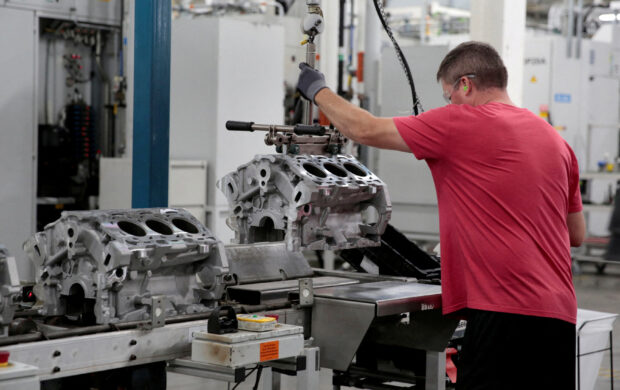US manufacturing recovering; raw material prices pose challenge

A General Motors assembly worker loads engine block castings on to the assembly line at the GM Romulus Powertrain plant in Romulus, Michigan, U.S. Aug 21, 2019. Rebecca Cook/File photo
WASHINGTON — U.S. manufacturing grew for the first time in 1-1/2 years in March as production rebounded sharply and new orders increased, but employment at factories remained subdued amid “sizable layoff activity” and prices for inputs pushed higher.
The survey from the Institute for Supply Management (ISM) on Monday suggested the sector, which has been battered by higher interest rates, was on the mend, though risks remain from rising raw material prices.
Timothy Fiore, who chairs the ISM’s manufacturing business survey committee, said “demand remains at the early stages of recovery, with clear signs of improving conditions.”
While the manufacturing rebound is a boost for the economy’s growth prospects, the rise in raw material prices suggested goods inflation could pick up in the months ahead. Goods deflation was the key driver of an inflation slowdown last year.
“If the contraction of manufacturing activity is over, far too soon to say, and price pressures are building in manufacturing, which appears to have been happening for the last three months, then this would have implications for the path for interest rates in 2024,” said Conrad DeQuadros, senior economic advisor at Brean Capital in New York.
READ: US manufacturing mired in weakness, economy heading for slowdown
The ISM said its manufacturing PMI increased to 50.3 last month, the highest and first reading above 50 since September 2022, from 47.8 in February.
The rebound ended 16 straight months of contraction in manufacturing, which accounts for 10.4 percent of the economy. That was the longest such stretch since the August 2000-January 2002 period.
A PMI reading above 50 indicates growth in the manufacturing sector. Economists polled by Reuters had forecast the PMI would rise to 48.4. The ISM and other factory surveys had grossly overstated the weakness in manufacturing, which has been constrained by higher borrowing costs.
Gainers, decliners
Government data on Thursday showed manufacturing output rose at an annualized rate of 0.9 percent in the fourth quarter. It grew 1.6 percent in 2023 compared to 0.8 percent in 2022. Though consumer spending has shifted to services, demand for goods remains supported.
Nine industries, including textile mills, paper products, primary metals, chemical products and transportation equipment, reported growth last month. Electrical equipment, appliances and components, machinery and computer and electronic products were among the six industries reporting a contraction.
Commentary from businesses was fairly upbeat. Makers of chemical products reported that “performance continues to defy projections of a downturn in activity,” adding that “demand remains strong, and the pipeline for orders is robust.”
READ: US manufacturing sector nears recovery; construction spending solid
Transportation equipment manufacturers said they were “expecting to see orders and production pick up for the second quarter.” Makers of wood products reported that “business activity is up,” adding that “many manufacturers are anticipating better business in the second quarter.”
But manufacturers of machinery struck a cautious note, saying they were “noticing an increase in suppliers’ selectiveness regarding orders they quote and take.” Makers of paper products were worried about “energy pricing.” Computer and electronic products manufacturers said “demand remains soft, but optimism is high that orders are ‘just on the horizon.'”
U.S. stocks were trading lower. The dollar rose against a basket of currencies. U.S. Treasury prices fell.
The ISM survey’s forward-looking new orders sub-index increased to 51.4 last month from 49.2 in February. Output at factories rebounded, with the production sub-index surging to 54.6 from 48.4 in the prior month.
New orders rebound
There was no sign of supply chain constraints from attacks on international shipping in the Red Sea by Yemen’s Houthi militants. But the ISM noted that “some suppliers are struggling to keep up.” The survey’s measure of supplier deliveries slipped to 49.9 from 50.1 in the prior month. A reading below 50 indicating faster deliveries.
Nonetheless, inflation at the factory gate picked up. The survey’s measure of prices paid by manufacturers rose to 55.8 from 52.5 in February, indicating raw materials prices increased last month. Twenty-four percent of companies reported higher prices compared to 18 percent in the prior month.
READ: US labor market steadily easing as job openings, resignations decline
Factory employment contracted for the sixth consecutive month, though at a moderate pace. Businesses reported continuing to reduce head counts through layoffs, which the ISM said accounted for 76 percent of the decline in employment, up from 50 percent in February. Attrition and hiring freezes were also being used by companies to trim head count.
The survey’s measure of manufacturing employment increased to 47.4 from 45.9 in February. This measure has, however, not been useful in predicting manufacturing payrolls in the government’s closely watched employment report.
While manufacturing has turned the corner, construction spending is taking a step back. A separate report from the Commerce Department on Monday showed construction spending unexpectedly dropped 0.3 percent in February after an unrevised 0.2 percent decline in January.
Strength in single-family homebuilding, which continues to underpin construction, was more than offset by weakness in nonresidential and public projects. Economists had forecast construction spending would rebound 0.7%. Construction spending increased 10.7 percent on a year-on-year basis in February.